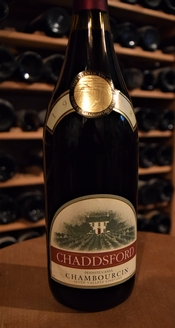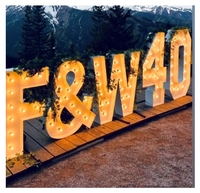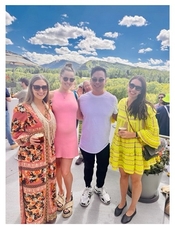|
|
 |
|
July 26, 2023
Even though I live on the East Coast, and even though the first vineyard I worked in was planted to Chambourcin and Seyval Blanc, 99.9% of my wine drinking and wine writing through the years have involved wines made solely from vinifera grapes. At the same time, the remaining one-tenth – French-American hybrids – has on occasion offered interesting results.
These exceptions have come from years of tasting, buying and on occasion cellaring French hybrid wines made by local Pennsylvania winemakers who find the hybrids better suited to their cold winters and humid summers. Most of these hybrid wines have been enjoyable and well-structured, though not on a par with “Old World” standard varieties.  That’s because, tasted fresh, hybrids, especially the reds, usually retain a bit of that foxy, grape-juicy characteristics as well as a papery undertaste coming from the native American grape component of the equation. That’s because, tasted fresh, hybrids, especially the reds, usually retain a bit of that foxy, grape-juicy characteristics as well as a papery undertaste coming from the native American grape component of the equation.
None of this surprises me, as I think grape variety, for good or bad, is the most important part of the winemaking trinity of Soil, Grape and Winemaker. The grape is only capable of producing the aromas and flavors that its DNA will allow. Soil will be simpatico with some grape varieties more than other. The winemaker, or at least those who are in control of their vineyards, can wrestle with these two components to come up with the juice and skins that she or he thinks can make the best wine possible (or most-profitable).
So it is with Chambourcin. Vidal Blanc and Seyval Blanc make interesting hybrid whites and sparkling wines, and Chambourcin seems to win out as a favorite red among winegrowers, with perhaps Foch coming in second.
During the years that Eric Miller was winemaker, co-owner and co-founder (with his wife Lee) of Chaddsford Winery in the Brandywine Valley of Pennsylvania – roughly from 1982 to 2013 – he made varietal Chambourcins along with vinifera standouts such as Chardonnay and Pinot Noir, largely from grapes sourced regionally. But, while enjoyable and easy drinking, the Chambourcins still retained some of the foxy characteristics, even when lightly chilled.
Nevertheless, I would buy a case or half case of most vintages of the Chambourcin, along with the vinifera wines, telling myself they would be good weekday wines and great for barbecues. However, during the 1990s I was re-building a depleted home cellar, so much of my drinking was of new bottles that might warrant a case. Many of the Chaddsford Chambourcins lay fallow in my basement.
When I again started writing about wines regularly at the turn of the current century, I quit collecting because wine samples began trickling in—and then pouring in. So, except for trophy bottles pulled when we were entertaining, the rest of my collection, mostly everyday wines, was largely neglected. Then, about five years ago, I realized I had to start drinking, or at least tasting, these older bottles or they would all turn bad.
Surprisingly, most hadn’t. Even the 30- to 40-year-olds were mostly sound, which really didn’t surprise me. First, I always purchased wines for my cellar that were well-balanced with good fruit and acidity, and I expected them to age as well as older bottles of Bordeaux, Burgundies, Rhônes and Riojas that winegrowers would pour during my press trips to Europe. Second, I am fortunate that both my wife and I enjoy older wines as well as, to quote Steve Martin in The Jerk, “fresh wines.”
So, I was pleased, though not surprised, to find that Miller’s Chaddsford’s Pinot Noirs were holding well and drinking well. The Chambourcins? We mostly ignored them, not expecting much. I opened one or two and in passing noted, “not too bad.” Then recently I opened a 1998 Chaddsford Chambourcin – 25 years old – and seriously paid attention. The ullage was good, and the cork sound (although cautiously extracted with an Ah So opener).
The wine was not in the least oxidized in taste or color, was full-bodied with ripe and still vibrant berry flavors, rich and long on the palate, still good structure with no tart acidity and with barely noticeable tannins. Not a great wine, but certainly a very, very good one that guests would marvel at both for its taste and age.
But the interesting thing is – and I had noticed this with earlier bottles – that foxy, papery hybrid taste had disappeared with aging. I had previously experienced a similar varietal “changeling” with Gamay on those occasions when a Beaune négociant pulled out an older bottle of cru Beaujolais to taste with the Côtes d’Or and Chalonnaise Pinots. Having spent several years in the bottle, the varietal characteristics of the Gamays were almost the same as the older Pinots and could even be confused as an old Pinot.
In this case, the Chambourcin did not taste like an older Pinot or Cabernet, but was very similar to an aged Grenache in its fruitiness and mellow nature. Apparently, something in the slow oxidation and aging process allows this to happen, all within the grape’s DNA limitations.
Recently, I was at a tasting hosted by Eric Miller of wine geeks and professionals who were comparing recent vintages of Burgundy and Oregon Pinot Noirs. I took along one of the Chaddsford Pinots from the late ‘90s, and even he was surprised at how well it was tasting. The contents of the bottle quickly disappeared. When I mentioned my experience with his Chambourcin and the apparent age-ability of that grape, Miller smiled and said, “Ah, but the winemaker has to know how to make the Chambourcin so that it is capable of aging.”
Hopefully, other talented and serious winemakers in the Eastern U.S. who produce varietal Chambourcins – and their wine fans who buy the bottles – will give a few of those wines a chance to age 10 to 20 years.
(Here, I had planned to end the blog, but there is a P.S.:)
Yesterday, I searched deeper into the cellar dust and unearthed a bottle of the first vintage of Chaddsford Chambourcin, a 1982 Reserve – 41 years old. It did not look too promising. Although, again, the ullage was very good, there were some sticky traces of leakage. I gingerly removed the cork which was on the verge of disintegration.
I took a sip, then decided to come back to it later. Old wines surprisingly often need a little air to knit back to life, just the opposite of conventional wisdom that air will suddenly convert them to vinegar. When I finally got around to tasting it, the word “tired” would be the best description – a bit maderized, still some fruit, still barely drinkable, but mainly the savory flavors of dried spices that had spent too many seasons in a McCormick’s shaker.
Evidently, even well-made aged Chambourcins have their limits.
Posted by Roger Morris at 3:41 PM
|
|
July 19, 2023
Franck Pascal (Champagne, France) Brut Nature “Fluence” NV ($80, Banville Wine Merchants) 94 Points: My recent (and first) encounter with this Champagne provided a striking and highly enjoyable experience. The “striking” dimension of the experience flowed from the enjoyment, because the wine is beautifully balanced and wonderfully intricate with no sugar added after disgorging (that's what Brut "Nature" means) and with no additional cellaring time after release. I  always lay down low- or no-dosage Champagnes for at least a year after I buy them—often significantly longer—but this bottle was a press sample from the importer, and I cracked into it straight away to review it. always lay down low- or no-dosage Champagnes for at least a year after I buy them—often significantly longer—but this bottle was a press sample from the importer, and I cracked into it straight away to review it.
That takes us back to the “striking” effect, as this wine is an object lesson in how the Champagne region is changing in ways that aren’t evident to those who only taste standard non-vintage bottlings from the big houses.
First, climate change is resulting in softer acidity profiles that don’t require the addition of sugar to produce balanced Champagnes. Second, this is true, but only truly beneficial for producers who tend vineyards carefully to yield excellent fruit, rather than relying on sugar as a cosmetic overlay to cover slipshod growing practices and uneven ripening. That’s true in this case, as evidenced by the fact that this is a biodynamically produced wine (certified by Biodyvin).
Third, balanced and complete-seeming Brut Nature Champagnes still require aging, but conscientious producers need to do that themselves, as most consumers don’t have cellaring capabilities and open wines they purchase right away. This was aged for four years on it yeast lees after the second fermentation, which resulted in both softening and greatly enhanced complexity that can be enjoyed immediately upon release.
Of course, holding wines for so long prior to sale is costly for producers, but the $80 price tag for this needs to be understood in context: This is significantly more intricate than standard-issue, non-vintage Brut NV wines from the big houses, which now sell for much higher prices than when inflation took off 18 months ago. According to winesearcher.com, the average price in the USA for Pol Roger Reserve “White Label” is now $65, and Veuve Cliquot “Yellow Label” is $71. As for Cuvée de Prestige Champagnes, Krug’s “Grande “Cuvée” now averages $261, and the 2012 vintage of Dom Perignon is $278.
All those numbers make $80 look a lot better than that price may have struck you at first glance.
One last point: The blend here is 54% Pinot Meunier, 26% Pinot Noir and 20% Chardonnay, and readers should be aware that Pinot Meunier is rising rapidly in reputation in Champagne. It was long regarded as a mere bet-hedger against spring frosts or late season rains, as it buds later and ripens more quickly than Chardonnay or Pinot Noir. Now one can find Champagnes made entirely from Pinot Meunier, and recent research has challenged whether the variety is even related to other members of the “Pinot Family.” France’s Institut National de la Recheche Agronomique (INRA) and the Champagne region’s Comité Interprofessionel du vin de Champagne (CIVC) now recommend calling it simply “Meunier.”
Of course, none of these details would be all that interesting if this Champagne were not delicious, but that’s exactly what it is, and you’ll find it as enjoyable as it is enlightening.
Posted by Michael Franz at 11:39 AM
|
|
July 5, 2023
I returned recently from the bacchanal that is the Aspen Food & Wine Classic. My memory is still a bit hazy, and my eyes are still blurry from three days and three longer nights of parties on top of parties. Over its four decades, the Food & Wine  Classic in Aspen has become an internationally buzzed-about festival where year after year, more than 5,000 attendees—including the world’s most famous chefs, Master Sommeliers, major liquor brands, and NBA superstars—head to 8,000 feet of altitude for Grand Tastings, sip-fueled lectures, cooking seminars and a never-ending number of dinners and late-night parties. Classic in Aspen has become an internationally buzzed-about festival where year after year, more than 5,000 attendees—including the world’s most famous chefs, Master Sommeliers, major liquor brands, and NBA superstars—head to 8,000 feet of altitude for Grand Tastings, sip-fueled lectures, cooking seminars and a never-ending number of dinners and late-night parties.
This was my first Aspen Food & Wine Classic, and it did not disappoint. Aspen is a town that makes Washington, D.C., real estate (my hometown) look like a sales bin at Target. When I landed at the Pitkin County airport, I knew I was in for a quintessentially Aspen experience with one glimpse of the majestic mountains and an inhalation of the crisp mountain air. As I waited in the airport for my former college roommate, Jaime, to arrive from Ohio, I felt like I was on a Top Chef All-Star casting call. The airport was teeming with Top Chef celebrities. And, yes, celebrity chefs really are everywhere, and they’re willing to chat it up and take pictures with us ordinary folk.
The entire event is an intricate choose-your-own-adventure. Ticket holders choose five seminars to attend throughout the weekend. Ostensibly, the event is about education, and among this year’s seminars that I attended included Anthony Gigilio's, “The Sicilian Wines of The White Lotus," in which the audience imbibed on the 2021 Planeta Etna Bianco, the Tornatore Etna Bianco, and the Donnafugata Dolce & Gabbana “Rosa” Rosato, to name a few. Anthony’s unpretentious style and playful enthusiasm made the tasting feel more like a raucous, boozy brunch than a stuffy tasting.
I also attended a phenomenal seminar with Bobby Stuckey and Carlin Karr, where they implored attendees to rethink what they know about Italian wine and to try the great French varieties grown in Italy. The 2020 Dalia Maris - Friulano Bianco B we sampled was enough to sell me on their thesis. Later, Mark Oldman introduced us to the charms of Australian wines, and we imbibed on some incredible wine as an all-star female panel led by June Rodil, Master Sommelier, walked us through the differences between Rioja and Ribera del Duero Tempranillo.
After and between the seminars, attendees can be found careening around the tremendous pavilions in Wagner Park. We were offered spoonfuls of caviar in the pavilions like they were free samples at Costco. Delectable small-bite dishes, oysters, Wagyu beef, and hand-carved Ibérico ham were everywhere. Not to mention the endless supply of mezcal margaritas, whiskey samples and heavy pours from famed wineries. It’s an incredible amount of excess – nothing quite like it. It's also worth noting that this unbelievably well-run event is primarily volunteer-led, and they operate like a Formula One pit crew.
 Hobnobbing with the likes of two-time Top Chef winner Buddha Lo, the lovable chef and TV personality Carla Hall, and NBA star CJ McCullum, who launched his own McCollum Heritage 91 wine label, while eating and drinking your way through the weekend was also pretty priceless (or at least worth $1,950, the price for a consumer pass). However, the best events aren’t part of the festival. It’s more about getting your name on the right lists for the parties that went down each night – with a blend of ticketed and free events supplying free-flowing wine, dynamic dishes, and the opulence only Aspen can offer. Hobnobbing with the likes of two-time Top Chef winner Buddha Lo, the lovable chef and TV personality Carla Hall, and NBA star CJ McCullum, who launched his own McCollum Heritage 91 wine label, while eating and drinking your way through the weekend was also pretty priceless (or at least worth $1,950, the price for a consumer pass). However, the best events aren’t part of the festival. It’s more about getting your name on the right lists for the parties that went down each night – with a blend of ticketed and free events supplying free-flowing wine, dynamic dishes, and the opulence only Aspen can offer.
Needless to say, the three-day-long celebration provided many great memories and stories – not all of them fit for print. I'll definitely be making my way back to the gastronomic festival again.
Posted by Miranda Franco at 4:40 PM
|
|
 |
|